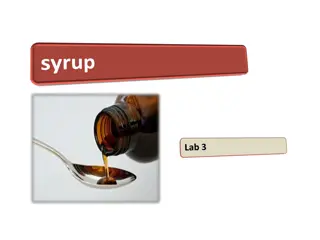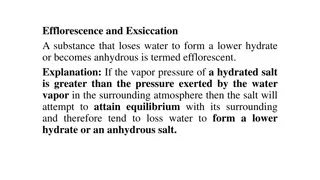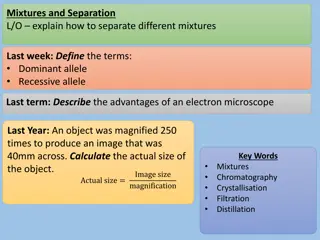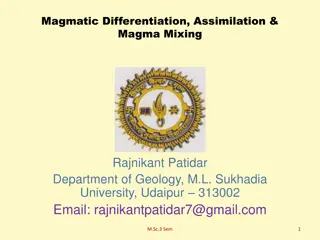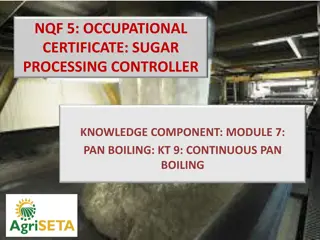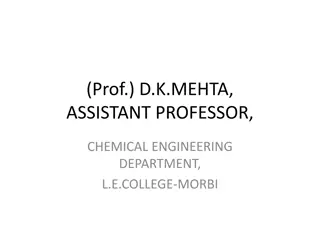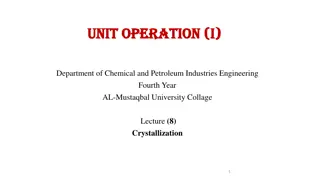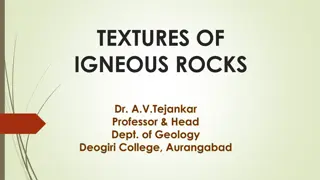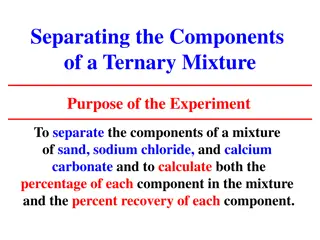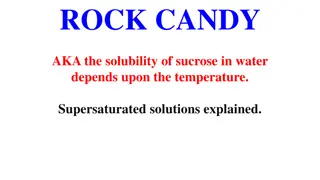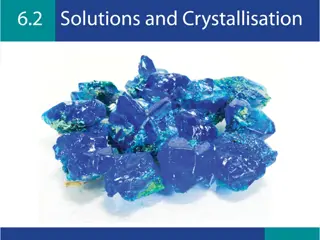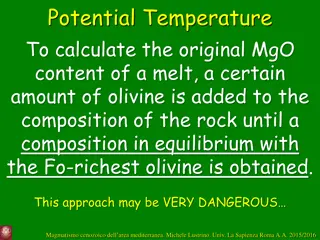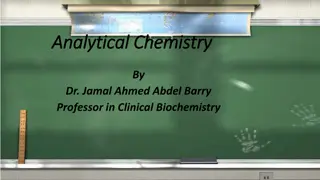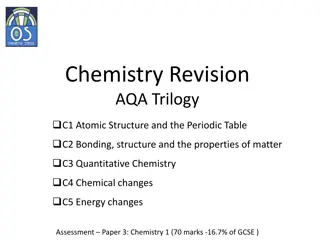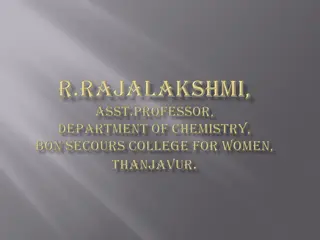Understanding Crystallization Process: Key Steps and Factors
Crystallization is a process where material deposits from a supersaturated solution, forming microcrystals that grow into larger crystals. Nucleation and growth are essential steps, with supersaturation driving crystal formation. Factors like temperature and seeding influence the process, leading to the spontaneous formation of crystals under specific conditions.
Download Presentation

Please find below an Image/Link to download the presentation.
The content on the website is provided AS IS for your information and personal use only. It may not be sold, licensed, or shared on other websites without obtaining consent from the author. Download presentation by click this link. If you encounter any issues during the download, it is possible that the publisher has removed the file from their server.
E N D
Presentation Transcript
Crystallization Crystallization differs from precipitation in that the product deposits from a supersaturated solution rather than from a liquid in which it is insoluble.
The basic steps in crystallization are 1. First to achieve a supersaturated solution 2. Then to provide nuclei on to which the material can deposit in the form of microcrystals (a few hundredths or even thousandths of a micron in size) Nucleation is known as the process whereby solute molecules are gathered into a small mass on which the crystals or amorphous form can continue growing; growth means there are more solute molecules coming onto this small mass.
3. And finally to allow these microcrystals to grow up to normal crystal dimensions so that they settle to the bottom of the vessel and can be separated from the supernatant liquid.
A solution must be saturated before any solid matter can crystalize out. If the temperature of a saturated solution is lowered or solvent evaporate from such a solution then the excess of solid material separates out. On lowering the temperature of a saturated solution very carefully, it is often possible to cool it considerably without the separation of crystals. Such a solution is said to be supersaturated.
The formation of crystals from solution involves two steps 1. The creation of crystalline nuclei 2. The growth of these nuclei into crystals Nuclei may arise spontaneously (rare), or they may arise by the introduction of minute crystals of the dissolve substance. This operation is known as seeding
The driving force for the nucleation and subsequent growth of the crystals is the supersaturation of the solution. The theory of Miers postulates that a definite relationship exist between the concentration and temperature at which crystals will spontaneously form in an unseeded solution.
The theory states that in the region between the two curves (metastable zone) spontaneous nucleation, but above the super solubility spontaneous nucleation. A solution of composition E will spontaneously crystalize and the solution concentration falls to that given by the normal solubility curve at that prevailing temperature i.e. point G. there will be no curve there is
A solution represented by point F in the metastable region will remain unchanged unless seeds are added and when nucleation occurs the concentration will again drop to point G.
In crystallization process the nuclei formation should be under control since the number of nuclei will control the size of the crystal. Large crystals may be obtained as a result of slow cooling of solution. Due to reduction in number of spontaneous nuclei; crystals grow from these few nuclei and will then grow to the desired size before new nuclei appears.
Conversely, rapid cooling increases the degree of supersaturation (beyond curve) resulting in a large number of nuclei and a crop of small crystals. Miers Supersaturation
Nuclei may originate in the following ways. 1. Spontaneously due to cooling an unseeded solution into the labile region 2. Deliberate seeding with minute crystals 3. Fortuitous (accidental/chance) seeding by crystals left from previous batch 4. Attrition of existing fragments that act as seeds. crystals giving rise to
Crystallization techniques The most important crystallization technique involves crystallization from a solvent. For this purpose a solvent in which the crystals are sparingly soluble in the cold and readily soluble in the hot is chosen.
The solid is added in portions to a suitable quantity of the hot solvent until a hot saturated solution is obtained. The hot solution is then filtered into a wide-mouthed conical flask and set aside to cool. Usually crystal separate during cooling.
Some substances particularly organic compounds form supersaturated solutions and no crystals are deposited on cooling the hot saturated solution. Crystallization in such cases may usually be initiated by seeding the supersaturated liquid with a crystal of the solid substance by stirring or by scratching the sides of the vessel with a glass rod.
Crystallization is sometime effected by strongly cooling a solution saturated at room temperature or by allowing such a spontaneously. The size of crystals usually depends upon the conditions of crystallization. solution to evaporate
Very small crystals are obtained by rapid cooling with frequent stirring of solutions almost saturated at their boiling point. Generally the production of very small crystals is avoided, because they tends to cohere into masses which are difficult to wash and consequently the substance may be less pure.
Medium-sized crystallizing from water, from solutions saturated at about 60-80 C. The hot solution is allowed to cool slowly and without mechanical disturbance. Very large crystals are obtained by setting aside a large volume of a solution and allowing it to evaporate spontaneously. crystals are obtained when
The mother liquor is the liquid remaining after a crop of crystals has been obtained. The mother liquor is not discarded and is subjected to further concentration and again set aside to crystalize. The second quantity of concentrated and a further crop of liquid is obtained. the mother liquor is
This process is repeated until practically the whole of the dissolve substance has been recovered. Crop of crystals obtained by concentration of the mother liquor are usually less pure than the first crop and may require recrystallization. The treatment of the mother liquor is very important on the commercial scale, crystallization of expensive substances such as alkaloids to avoid serious financial loss. in the particularly
Applications in Pharmacy The process of crystallization afford a method for the purification of crystalline substances It is also important to control polymorphism which in tern affects various parameters such as stability, solubility and bioavailability


